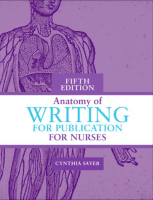Use social media and news sites to promptly share your scholarly work.
Takeaways
- Social media platforms and news outlets contribute to the swift and vast dissemination of scholarly work.
- Authors should take advantage of these opportunities to increase exposure to their scholarly work within the digital world.
- Your organization’s public relations department, nursing organizations, and publishers can provide guidance in using social media to share your work.
According to the Pew Research Center, data from 2018 show that over 35% of adults gather information from online sources, with 15% searching social media and 23% seeking out news websites. Only 16% rely on print newspapers. Pew Research Center also reported that approximately 70% of Americans stated that they had visited a social media platform to obtain information. As a result, many industries, including healthcare, turn to social media and other online platforms to share data, news, and scholarly work.
Scholarly work drives exceptional clinical care, informs policy, and contributes to a foundation of new knowledge. Disseminating findings from research studies, evidence-based practice projects, and quality improvement initiatives brings new information to healthcare professionals, patients, and families. To effectively influence additional research or promote clinical change, scientific information must be passed on to those in positions to accurately interpret, discuss, and when relevant, implement it. Without dissemination, new findings go unnoticed and healthcare becomes stagnant.
Dissemination of scholarly work frequently occurs via poster sessions or podium presentations (both in-person and virtual) at local, national, and international conferences and symposia. However, many consider journal publication as the final and primary route for fully distributing scientific findings. The marriage of journal publication with broader online dissemination is the key to ensure new findings make an impact on the broader healthcare community.
Journals and online dissemination
Over the decades, journal articles that once were available only in print have transitioned to online options. This shift opened the door for broader access to journal content via search engines, library systems, and individual journal subscriptions. Today, however, various digital communication platforms—including social media and online news outlets—provide additional options for large-scale promotion of journal articles. Rather than relying solely on journal marketing, online search engines, and word of mouth, you can promote your article using listservs, Twitter, Facebook, YouTube, LinkedIn, and news media. These platforms push new information to the larger community and supplement the traditional strategies used by colleagues seeking new information.
Marketing departments and professional organizations
Online publication support can take several forms and be used simultaneously. Begin by sharing your publication announcement within your institution or organization, then contact your marketing or media department, which should be eager to blast out a statement such as “Nurses reduce symptoms of long-term COVID” through various media outlets. You’ll have opportunities to share a summary of your findings with local news media who can air the information regionally while also funneling the scholarly work to larger news agencies with a bigger footprint. Depending on the novelty of the findings or the perceived importance of the work, news agencies may run the story across numerous reporting venues.
Using social media, you can achieve similar outcomes. Again, turn to your organization’s marketing or media department for help navigating these platforms and for posting in forums that would most likely grab onto the new information and promote it.
Also turn to professional organizations for support. If you’re a member, you’ll have access to their listservs, websites, and social media platforms. If the published topic is of interest to the organization’s membership, it may help you distribute the publication announcement. All professional organizations want to share current, pertinent clinical findings that contribute to optimized care, enhance the clinical environment, and support team member professional development.
Independent dissemination


Also consider creating a brief video summary of your article to post on your Facebook, YouTube, and LinkedIn pages. In just a few minutes, you can explain the nuances of your project and highlight key takeaways. (See Dissemination tips.)
Dissemination tips
Consider these tips when preparing to share your published work:
- Establish a personal professional social media account.
- Never include patient information.
- Be factual.
- Keep it succinct.
- Be mindful of your audience and use common language.
- Convey key concepts.
- Determine key words to draw attention.
- Reference your primary work and include a digital object identifier when possible.
- Within the post, ask others to share.
- Develop a plan to follow and respond to comments.
Journal parameters
Before you begin disseminating your article, review the details of your copyright agreement with the journal. This signed contract covers distribution and sharing of the published material as well as approved dissemination approaches and timeframes. To ensure you uphold your contractual obligations, you must understand this agreement before embarking on any form of media sharing.
Visit the How Can I Share It website for guidance on best practices for collaborating and sharing scholarly works. Also ask the journal that published your article for suggestions and recommendations. (American Nurse Journal shares a dissemination guide with all published authors.)
Legal counsel also can help answer questions about copyright and dissemination processes. When in doubt, err on the side of caution and only release the publication citation, not the entire published article.
Platform selection
After confirming the details of the journal contract, you’re ready to select the media platform that targets the readership communities most interested in your findings. You’ll also need to decide if you want to use more than one platform. The larger the net you cast, the more individuals you’ll reach, but you have to consider the number of potential dialogues that may follow and your ability to sustain multiple conversations.
Depending on the type of media platform you choose, you may quickly connect with policymakers, international colleagues, or a wider audience, including the general public. Immediate sharing of new information and same-day connections with new peer networks occur at a scope and pace that once took years to accomplish. (See Dissemination in action.)
Dissemination in action
The COVID-19 pandemic offers an excellent example of the rapid push of new information to the masses. The virus and its many unknowns spurred those in the scientific and healthcare communities to rapidly share new findings using social media, news outlets, and other technologies. Evidence-based practices such as prone positioning were uploaded on a host of platforms to guide administrators and clinicians in the tools and techniques to safely position patients in respiratory distress and optimize pulmonary function.
Social media and news outlets facilitated the spread of this essential intervention during a time when information sharing was critical to the health of the world. According to Tornburg and colleagues, during the first 6 months of the pandemic, the top 100 original print articles about COVID-19 were disseminated more quickly via social media (most commonly Twitter) than standard journal circulation.
Ready, set, go
Rapidly disseminating scholarly work via social media and news outlets is changing how the professional community and the general public receive and share healthcare information. These technological advances help authors quicky distribute new findings and immediately direct colleagues from across the globe to the publication. Authors swiftly build scholarly networks, and consumers promptly assimilate new findings.
With instant access to the latest science, clinicians, administrators, and researchers are poised to enhance patient care, advance policy change, and promote scientific growth with new speed. Hold on tight—scholarly healthcare content has entered the information highway and the race is on.
Beth Quatrara is an assistant professor at the University of Virginia School of Nursing in Charlottesville.
References
Auxier B, Anderson M. Social media use in 2021. Pew Research Center. April 7, 2021.
Cook CE, O’Connell NE, Hall T, et al. Benefits and threats to using social media for presenting and implementing evidence. J Orthop Sports Phys Ther. 2018;48(1):3-7. doi:10.2519/jospt.2018.0601
Dockter CE, Lee S, Boman CD, Hinnant A, Cameron GT. The impact of retransmission and modality on communicating health research findings via social media. Health Commun. 2021;36(10):1231-41. doi:10.1080/10410236.2020.1749354
Escoffery C, Kenzig M, Hyden C, Hernandez K. Capitalizing on social media for career development. Health Promot Pract. 2018;19(1):11-5. doi:10.1177/1524839917734522
Geiger AW. Key findings about online news landscape in America. Pew Research Center. September 11, 2019.
Tornberg HN, Moezinia C, Wei C, et al. Assessing the dissemination of COVID-19 articles across social media With altmetric and PlumX metrics: Correlational study. J Med Internet Res. 2021;23(1):e21408. doi:10.2196/21408
Trethewey SP. Medical misinformation on social media: Cognitive bias, pseudo-peer review, and the good intentions hypothesis. Circulation. 2019;140(14):1131-3. doi:10.1161/CIRCULATIONAHA.119.041719
Key words: dissemination, social media, online, and news


















